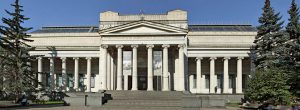After he had finished excavating, Schliemann smuggled the “Trojan” treasures out of Turkey and back to Germany, where they would remain hidden under what was the Berlin Zoo until 1945 when they went missing.1 Priam’s treasures were then stolen from the Germans by the Russians, and taken to the place where they reside today- the Pushkin Museum in Moscow, Russia.

For decades, the Soviet Government denied any knowledge of the 4,500-year-old treasures, which had been unearthed on the site of ancient Troy between 1873 and 1890 by Schliemann. President Boris Yeltsin finally admitted the truth in 1993, and in 1996 there was the first exhibition of the Treasure. 2
“Many journalists call it theft,” said Mr. Tolstikov, “but it’s reparation for damage inflicted on our country in World War II. In any case, we can speak only of the exchange of valuables, not their restitution.”3
- Tribune News Services. “Russia Unveils Trojan Treasures.” Chicago Tribune. April 16, 1996. http://articles.chicagotribune.com/1996-04-16/news/9604160105_1_trophy-art-trojan-gold-major-treasures ↵
- Erlanger, Steven. “Digging Out Schliemann’s Treasure at the Pushkin.” The New York Times, December 11, 1994. http://www.nytimes.com/1994/12/11/arts/art-digging-out-schliemann-s-treasure-at-the-pushkin.html?pagewanted=all ↵
- Hoffman, David. “Russia Shows Off Troy’s Treasures.” The Washington Post. April 20, 1996. https://www.washingtonpost.com/archive/lifestyle/1996/04/20/russia-shows-off-troys-treasures/ab398dc0-e7a3-43fa-ba6c-6fc2ec704d4d/ ↵